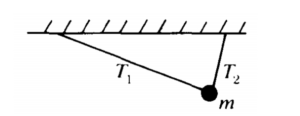Question
Multiple correct: Three forces act on an object. If the object is moving to the right in translational equilibrium, which of the following must be true? Select two answers.
(A) The vector sum of the three forces must equal zero.
(B) All three forces must be parallel.
(C) The magnitudes of the three forces must be equal.
(D) The object must be moving at a constant speed.
▶️Answer/Explanation
Ans: A, D
Solution: (A) is the definition of translational equilibrium. Equilibrium means no net force and no acceleration, so (D) is also correct.
Question
For which of the following motions of an object must the acceleration always be zero?
(A) Any motion in a straight line
(B) Simple harmonic motion
(C) Any motion at constant speed
(D) Any single object in motion with constant momentum
▶️Answer/Explanation
Ans:D
Solution: Motion at constant speed includes, for example, motion in a circle, in which the direction of the velocity changes and thus acceleration exists. Constant momentum for a single object means , that the velocity doesn’t change.
Question

A ball of mass m is suspended from two strings of unequal length as shown above. The magnitudes of the tensions T1 and T2 in the strings must satisfy which of the following relations?
(A) Tl = T2 (B) T1 > T2 (C) T1 < T2 (D) Tl + T2 = mg
▶️Answer/Explanation
Ans:C
Solution: As T2 is more vertical, it is supporting more of the weight of the ball. The horizontal components of T1 and T2 are equal.
